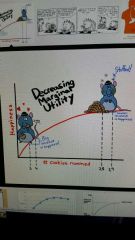![]()
![]()
![]()
Use LEFT and RIGHT arrow keys to navigate between flashcards;
Use UP and DOWN arrow keys to flip the card;
H to show hint;
A reads text to speech;
33 Cards in this Set
- Front
- Back
|
Marginal Utility and (positive, negative)
|

The additional satisfaction a consumer gains from consuming one more unit of a good or service. determines how much a consumer will buy.
Positive: when the consumption of an additional item increases the total utility. Negative: when the consumption of an additional item decreases the total utility. |
|
|
Marginal Rate of Subsitution
|
In economics, the marginal rate of substitution is the rate at which a consumer is ready to give up one good in exchange for another good while maintaining the same level of utility.
|
|
|
Indifference Curve
|
In microeconomic theory, an indifference curve is a graph showing different bundles of goods between which a consumer is indifferent. That is, at each point on the curve, the consumer has no preference for one bundle over another.
|
|
|
Marginal Rate of Subsitution MRS Formula
|
MRS=CHANGE IN Y/CHANGE IN X
|
|
|
Opportunity cost of activity
|
The value of all that must be sacrificed to do X
|
|
|
Reservation price of activity X
|
The price at which a person would be in different between doing X and not doing X
|
|
|
Marginal cost
|
The increase in total cost that results from carrying out one additional unit of an activity
|
|
|
Marginal benefit
|
The increase in total benefit that results from carrying out one additional unit of an activity
|
|
|
Average Cost
|
The activity costs of undertaking n units of an activity is the total cost of the activity divided by n
|
|
|
Average benefit
|
The average benefit of undertaking n unit of an activity is the total benefit of activity divided by N
|
|
|
External cost of an activity
|
A cost that falls on people who are not directly involved in the activity
|
|
|
Normative Question
|
A question about what policies or institutional arrangements leave to best outcome
|
|
|
Positive Question
|
A question about the consequences of specific policies or institutional arrangements
|
|
|
Real Price of a Product
|
Its price relative to the prices of other goods and services
|
|
|
Law of Demand
|
The empirical observation that when the price of a product falls, people demand larger quantities of it.
|
|
|
Excess supply
|
The amount by which quantity supplied exceeds quantity demanded
|
|
|
Law of supply
|
The empirical observation that when the price of a product rises firms offer more of it for sale
|
|
|
Excess demand
|
The amount by which quantity demanded exceeds quantity supplied
|
|
|
Price ceiling
|
Level above which the price of a good is not permitted by law to rise.
|
|
|
Price floor
|
A minimum price for a good, established by law, and supported by governments offer to buy the good at that price.
|
|
|
rationing function of price
|
the process whereby price direct existing supply of a product to the users who value it most highly
|
|
|
allocative function of price
|
The process whereby price acts as a signal that guides resources away from the production of goods whose prices lie below cost towards the production of good whose prices exceed cost
|
|
|
bundle
|
a particular combination of two or more goods.
|
|
|
Budget constraint
|
The set of all bundles that exactly exhaust the customers income at given prices also called the budget line
|
|
|
Affordable set
|
Bundles on or below the budget constraint; bundles for which the required expenditure at given prices is less than or equal to the income available.
|
|
|
Composite good
|
In a choice between good X and numerous other goods, the amount of money the consumer spends on those other goods.
|
|
|
preference ordering
|
A ranking of all possible consumption bundles in order of preference.
|
|
|
Indifference curve
|
A set of bundles among which the consumer is indifferent
|
|
|
Indifference map
|
A representation sample of the set of consumers indifferent curve, used as a graphical summary of her preference ordering.
|
|
|
Marginal rate of substitution
|
At any point on the indifference curve, the rate at which the consumer is willing to exchange the goods and measured along the vertical axis for the good measured along the horizontal axis . Equal to the absolute value of the slope of the indifference curve.
|
|
|
Best affordable bundle
|
The most preferred bundle of those that are affordable
|
|
|
Corner solution
|
In a choice between two goods, a case in which the consumer does not consume one of the goods.
|
|
|
price-consumption curve (PPC)
|
Holding income and the price of Y constant , the PCC for good X is the set of optimal bundles traced on an indifference map as a price of X varies.
|

